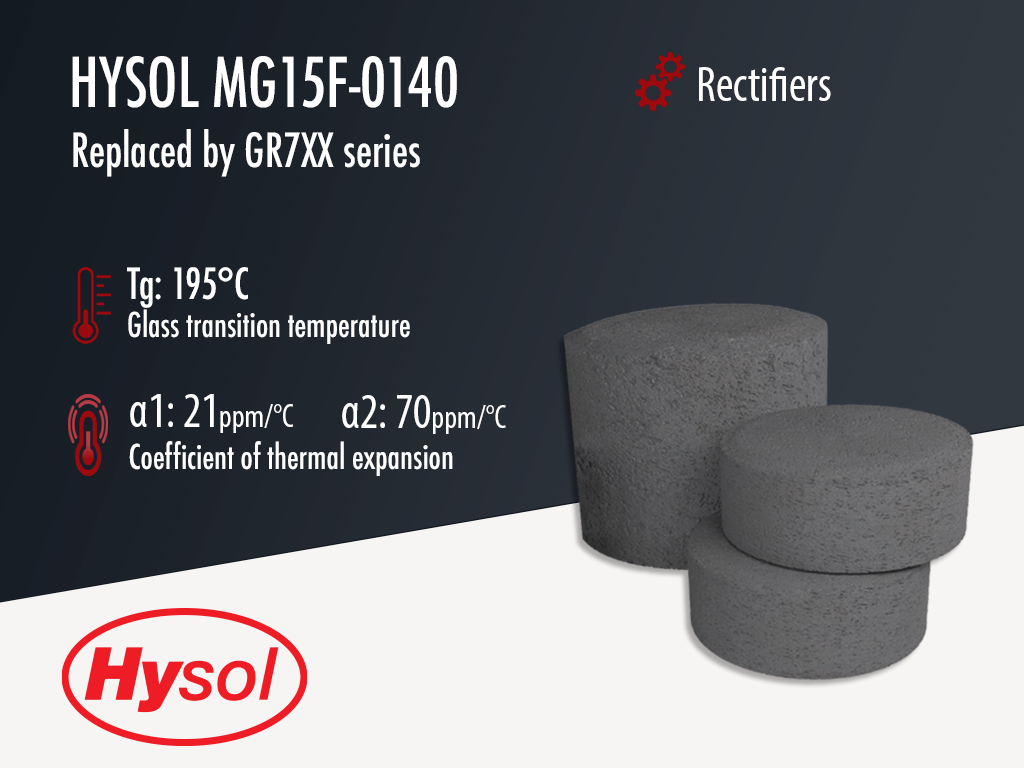Hysol MG15F-0140 | Black Epoxy Mold Compound
Harmonization Code : 3907.30.00.90 | Polyacetals, other polyethers and epoxide resins, in primary forms; polycarbonates, alkyd resins, polyallyl esters and other polyesters, in primary forms : Epoxide resins : Other
Main features
- Anhydride cured
- Tg: 195°C
- For power discretes and high voltage rectifiers
Product Description
Hysol MG15F-0140 is a black, semiconductor grade, anhydride curing epoxy molding compound designed for high voltage power applications requiring good electrical stability at high temperature. A real classic. The work horse, as the industry would call it, product of the halogen and anhydride containing chemistries.
Hysol MG15F-0140 was typically used for power discretes and high voltage rectifiers. Despite its glorious history, the industry has been leaning towards next generation compounds that are future proof while still maintaining the same, or sometimes even better mold properties. GR 750 and the GR 750 XX series in general have nothing to envy and are good drop in candidates for the old guard.
MG15F-0140 will be discontinued by end of this year since its flame retardant (Dechlorane Plus) will be banned by the Chinese government by 2024. MG15F-0140 will be replaced with MG15F-0140B.
Technical Specifications
| General Properties | |||||||||
| Color Color The color | Black | ||||||||
| Filler Content | 69 % | ||||||||
| Specific Gravity Specific Gravity Specific gravity (SG) is the ratio of the density of a substance to the density of a reference substance; equivalently, it is the ratio of the mass of a substance to the mass of a reference substance for the same given volume. For liquids, the reference substance is almost always water (1), while for gases, it is air (1.18) at room temperature. Specific gravity is unitless. | 1.81 | ||||||||
| |||||||||
| Physical Properties | |||||||||
| Spiral Flow @ 175°C | 50.8 cm | ||||||||
| Chemical Properties | |||||||||
| |||||||||
| Moisture absorption | 0.65 % | ||||||||
| Electrical Properties | |||||||||
| |||||||||
| Volume Resistivity Volume Resistivity Volume resistivity, also called volume resistance, bulk resistance or bulk resistivity is a thickness dependent measurement of the resistivity of a material perpendicular to the plane of the surface. | 6.3x1016 Ohms⋅cm | ||||||||
| Mechanical Properties | |||||||||
| |||||||||
| |||||||||
| |||||||||
| Thermal Properties | |||||||||
| |||||||||
| |||||||||
| Glass Transition Temperature (Tg) Glass Transition Temperature (Tg) The glass transition temperature for organic adhesives is a temperature region where the polymers change from glassy and brittle to soft and rubbery. Increasing the temperature further continues the softening process as the viscosity drops too. Temperatures between the glass transition temperature and below the decomposition point of the adhesive are the best region for bonding. The glass-transition temperature Tg of a material characterizes the range of temperatures over which this glass transition occurs. | 195 °C | ||||||||
| Thermal Conductivity Thermal Conductivity Thermal conductivity describes the ability of a material to conduct heat. It is required by power packages in order to dissipate heat and maintain stable electrical performance. Thermal conductivity units are [W/(m K)] in the SI system and [Btu/(hr ft °F)] in the Imperial system. | 0.66 W/m.K | ||||||||
| UL 94 Rating UL 94 Rating Flammability rating classification. It determines how fast a material burns or extinguishes once it is ignited. HB: slow burning on a horizontal specimen; burning rate less than 76 mm/min for thickness less than 3 mm or burning stops before 100 mm V-2: burning stops within 30 seconds on a vertical specimen; drips of flaming particles are allowed. V-1: burning stops within 30 seconds on a vertical specimen; drips of particles allowed as long as they are not inflamed. V-0: burning stops within 10 seconds on a vertical specimen; drips of particles allowed as long as they are not inflamed. 5VB: burning stops within 60 seconds on a vertical specimen; no drips allowed; plaque specimens may develop a hole. 5VA: burning stops within 60 seconds on a vertical specimen; no drips allowed; plaque specimens may not develop a hole | V0 | ||||||||
| Curing Conditions | |||||||||
| |||||||||
| |||||||||
| Transfer Time | 6 - 15 s | ||||||||



